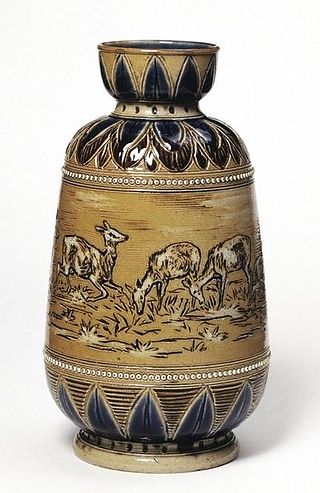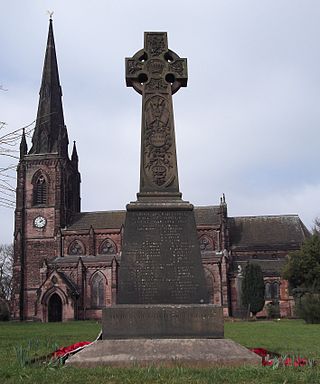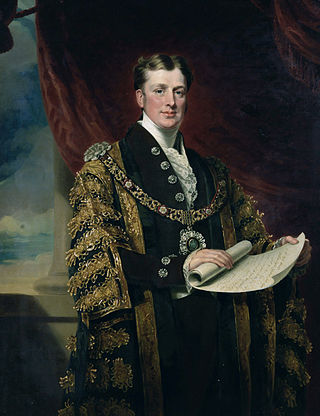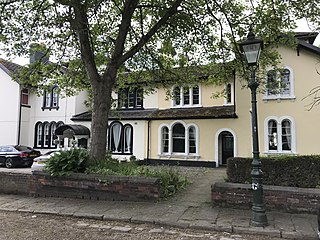Colin Campbell may refer to:

Wedgwood is an English fine china, porcelain and luxury accessories manufacturer that was founded on 1 May 1759 by the potter and entrepreneur Josiah Wedgwood and was first incorporated in 1895 as Josiah Wedgwood and Sons Ltd. It was rapidly successful and was soon one of the largest manufacturers of Staffordshire pottery, "a firm that has done more to spread the knowledge and enhance the reputation of British ceramic art than any other manufacturer", exporting across Europe as far as Russia, and to the Americas. It was especially successful at producing fine earthenware and stoneware that were accepted as equivalent in quality to porcelain but were considerably cheaper.

Royal Doulton is an English ceramic and home accessories manufacturer that was founded in 1815. Operating originally in Vauxhall, London, and later moving to Lambeth, in 1882 it opened a factory in Burslem, Stoke-on-Trent, in the centre of English pottery. From the start, the backbone of the business was a wide range of utilitarian wares, mostly stonewares, including storage jars, tankards and the like, and later extending to drain pipes, lavatories, water filters, electrical porcelain and other technical ceramics. From 1853 to 1901, its wares were marked Doulton & Co., then from 1901, when a royal warrant was given, Royal Doulton.

Thomas Minton (1765–1836) was an English potter. He founded Thomas Minton & Sons in Stoke-on-Trent, Staffordshire, which grew into a major ceramic manufacturing company with an international reputation.

Mintons was a major company in Staffordshire pottery, "Europe's leading ceramic factory during the Victorian era", an independent business from 1793 to 1968. It was a leader in ceramic design, working in a number of different ceramic bodies, decorative techniques, and "a glorious pot-pourri of styles - Rococo shapes with Oriental motifs, Classical shapes with Medieval designs and Art Nouveau borders were among the many wonderful concoctions". As well as pottery vessels and sculptures, the firm was a leading manufacturer of tiles and other architectural ceramics, producing work for both the Houses of Parliament and United States Capitol.

Penkhull is a district of the city of Stoke-on-Trent, Staffordshire, England, part of Penkhull and Stoke electoral ward, and Stoke Central parliamentary constituency.

Hartshill is a suburb and historic township of Stoke-on-Trent in Staffordshire, England.

William Taylor Copeland, MP, Alderman was a British businessman and politician who served as Lord Mayor of London and a Member of Parliament.

Pâte-sur-pâte is a French term meaning "paste on paste". It is a method of porcelain decoration in which a relief design is created on an unfired, unglazed body, usually with a coloured body, by applying successive layers of (usually) white porcelain slip with a brush. Once the main shape is built up, it is carved away to give fine detail, before the piece is fired. The work is very painstaking and may take weeks of adding extra layers and allowing them to harden before the next is applied.

Michael Thomas Bass, DL was an English brewer and a Member of Parliament. Under his leadership, the Bass Brewery became the largest brewery in the world, and Bass the best known brand of beer in England. Bass represented Derby in the House of Commons as a member of the Liberal Party between 1848 and 1883 where he was an effective advocate for the brewing industry. He was a generous benefactor both in Derby, and in Burton-on-Trent where his company was based.

Sir George Granville Leveson-Gower KBE, was a British civil servant and Liberal politician from the Leveson-Gower family. He held political office as Comptroller of the Household between 1892 and 1895 and later served as a Commissioner of Woods and Forests from 1908 to 1924. In 1921 he was knighted.

William Woodall, was a British Liberal politician, philanthropist and supporter of women's suffrage.

The Villas, Stoke-on-Trent, is an estate of 24 Victorian houses in Stoke-upon-Trent, England. Originally a distinct settlement set in green fields, it now merges with the late 19th- and early 20th-century suburban sprawl along London Road below Penkhull village on the outskirts of Stoke-on-Trent and within the ward of Stoke and Trent Vale.
Arthur Howard Heath TD was a British industrialist, first-class cricketer, Rugby union international and Conservative Party politician.

Edward Frederick Leveson-Gower DL, JP, styled The Honourable from birth, was a British barrister and Liberal politician. He was commonly known under his second forename and was sometimes nicknamed Freddy Leveson.

Marc-Louis-Emmanuel Solon, pseudonym Miles, was a renowned French porcelain artist. After beginning his career at the Sèvres Pottery, he moved to Stoke-on-Trent in 1870 to work at Mintons Ltd, where he became the leading exponent of the technique of ceramic decoration called pâte-sur-pâte. His work commanded high prices in the late Victorian period.

William Bromley-Davenport, also known as Davenport and Davenport-Bromley, was an English Conservative politician who sat in the House of Commons from 1864 to 1884.

The Turner family of potters was active in Staffordshire, England 1756-1829. Their manufactures have been compared favourably with, and sometimes confused with, those of Josiah Wedgwood and Sons. Josiah Wedgwood was both a friend and a commercial rival of John Turner the elder, the first notable potter in the family.
Charles Lynam was an English architect, designing many public buildings and churches in the Stoke-on-Trent area. He was also a church historian, archaeologist, and preservationist.
















